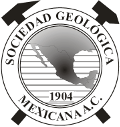|
BOLETÍN DE LA SOCIEDAD GEOLÓGICA MEXICANA, V. 53, n. 1, (2000) 1-26 http://dx.doi.org/10.18268/BSGM2000v53n1a1 |
|
Tectónica de la Sierra Madre Oriental, México
Samuel Eguiluz de Antuñano1, Mario Aranda García1 y Randall Marrett2
1 PEMEX EXPLORACiÓN, Residencia Reynosa
2 Department of Geological Sciences, University of Texas at Austin. 78712-1101
This email address is being protected from spambots. You need JavaScript enabled to view it.
Abstract
The Sierra Madre Oriental (SMO) is a long range that resulted from the deformation of Mesozoic rocks and its basament complex. Both were. uplifted, shortened and transported northeastward forming a fold and thrust belt during the Laramide orogeny. This work describes the structural styles that form the frontal zone of the geological province SMO.
AJong the front of this fold and thrust belt, ñve sectors can be distinguished by internal variants in their style and trend of deformation, here considered thin-skinned kind.
The sedimentary evolution and facies distribution, both controlled by the paleogeography, had direct influence over folding development. Oxfordian evaporites in the Central Mexico Basin, and Cretaceous evaporites in the Valles-San Luis Potosí Platform, caused detachments and created structural salients, box folds, and a few emergent faults. Restored and balanced cross-sections show that where evaporites exist, shortening is less than 35%. Where evaporites are absent, shortening was greater than 40%. Kinematic vectors suggest a regional northeastward tectonic transporto
New data suggest that sediment accumulated in the frontal SMO was much thicker than presently preserved. Uplift, folding and thrusting of this sequence possibly occurred during late Eocene. This idea explains that Jurassic-Cretaceous schist, could be for litostathic pressure in some frontal folding places; and the compressing and uplift could be post Eocene in that region, but not extensive in that time across western the SMO.
The critical wedge model can explain: (1) structural relationships based on evaporite distribution and the structural salient; (2) differences between the geometry of structures along the front range; (3) contrasting deformation styles between the basement complex and the sedimentary cover; (4) shortening variations and (5) the location of outcrops of the internal zone of the fold-thrust belt.


